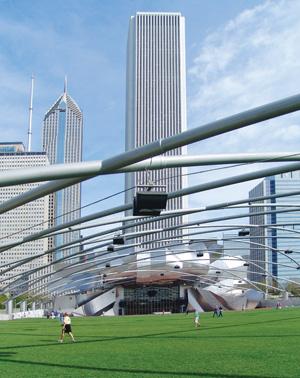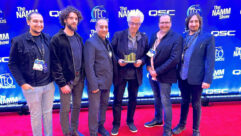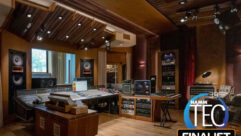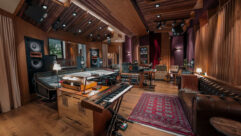

Jack of all Acoustics
Since the invention of amplified sound, the focus on proper acoustics and the race to improve the listening experience has taken audio professionals through myriad solutions. As audio technology evolved, more complex applications emerged. Eventually architects and acousticians joined in to help achieve the goal of good sound at every seat.
DEVIL IN THE DETAILSENHANCEMENT APPLICATIONSWHAT IT MEANS TO AV PROS
Chicago’s Millennium Park is home to the 95,000-square-foot Frank Gehry–designed Pritzker Pavilion. LARES Associates installed its electronic acoustic enhancement (EAE) system to give concert-goers sitting in the lawn area the same acoustic experience as those sitting inside the pavilion.
Credit: Courtesy Wayne Lorentz | Artefaqs.com
SINCE THE INVENTION OF AMPLIFIED sound, the focus on proper acoustics and the race to improve the listening experience has taken audio professionals through myriad solutions. As audio technology evolved, more complex applications emerged. Eventually architects and acousticians joined in to help achieve the goal of good sound at every seat. Then, as if to complicate matters, purpose-built venues gave way to multipurpose facilities that served varying acoustical needs.
Advancements in digital signal processing (DSP) have raised the profile of acoustic enhancement systems, meant to address multiple acoustical needs in one space. Rather than using sound absorptive materials to tame an acoustically live space, these electronic systems require an acoustically “dry” venue into which sound energy is introduced to provide a rich, reverberant experience.
“There is no ‘wow’ factor with these systems. If you notice it, then it’s not done right,” says Vance Breshears of Sound Technology Consultants in El Cajon, Calif., who wrote a white paper on the topic and has designed many acoustic enhancement systems for houses of worship. “The system enhances the listening experience, but you just don’t know it’s there.”
Several companies make acoustic enhancement systems. One is LARES Associates in Belmont, Mass., which describes its electronic acoustic enhancement (EAE) system as the use of electroacoustics to mimic or augment architecture. “But its uses extend beyond that application. It is the most expensive technology that you purchase—and that you should never notice,” says Steve Barbar, president of LARES. “In general, it is best used when a venue must support multiple artists, each requiring different acoustical conditions.”
Meyer Sound Labs in Berkeley, Calif., entered the market in 2005 when it acquired LCS Audio and its variable room acoustic system (VRAS) technology. Since then, Meyer Sound launched VRAS, packaged with Stella loudspeakers and certified microphones, as the Constellation electroacoustic architecture.
According to John Pellowe, project director of Constellation systems for Meyer Sound, electroacoustic architecture is pairing electroacoustic technology with acoustic design. “Rarely do perfect acoustical environments exist,” he says. “Constellation integrates with the architecture and vice versa.”
Pat Brown, president of audio education firm Syn-Aud-Con and former PRO AV columnist, has worked extensively in the field of architectural acoustics and acoustics measurements, and also with potential users of electronic acoustic enhancement systems. He says, “Potential venue candidates are those whose use is limited by the room having only one acoustical characteristic. Houses of worship are a good example, as traditional music benefits from a very live or reverberant space, yet contemporary music needs a very dry space. Many houses of worship are finding that there is no ‘one size fits all’ acoustical signature for a room.”
At first glance, an acoustic enhancement system may look like a distributed sound system on steroids. An enhancement system for a large sanctuary or concert hall can have more than fifty microphones and twice as many loudspeakers. The most important thing to remember is that these systems can only add acoustical energy and work best in an acoustically dry space (ideally with a reverberation time of less than 1.2 seconds). Venues with existing acoustical problems or ones that are extensively lively are not good candidates for an acoustic enhancement system.
The delicate functions of these systems mean hardware components must have specific characteristics, such as power uniformity for loudspeakers and high sensitivity and low noise for microphones. LARES-branded products integrate hardware from various manufacturers and use custom software developed specifically for acoustic enhancement.
In all cases, user preference for hardware is not an option. “Previously, the user could choose what components they wanted and there was a mismatching of characteristics. With known devices, it becomes cooperatively easy to design. The alternative is too hit or miss,” says Pellowe.
The ideal space would be free of flutter echoes, standing waves, and other tonal resonances. “To build a system, we must take into account room geometry and the physics of the space,” says Barbar. “The system design hinges on primary uses of the venue since that determines the desired acoustical characteristics.”
Loudspeakers and microphones in an acoustic enhancement system have de-correlated signals. In a Constellation system, each channel of the system is independent. “Each processor has 16 outputs and we may have several processors in a system. By careful matrixing, we can ensure no two adjacent loudspeakers have coherent signals,” explains Pellowe. “Also, each channel can be independently equalized and time delayed.”
A LARES system generates a time variance that de-correlates the signal in real time. “As a result, LARES systems can be built with far fewer independent channels, reducing the enormous complexity required in previous systems,” says Barbar. “In practice, the system can have two to four microphones placed in close proximity to loudspeakers without inducing coloration. LARES incorporates digital reverberation, and utilizes independent de-correlation for both early and late energy.”
The “dry” acoustics in this 1,400-seat theater on the campus of Universidad Laboral in Gijon, Spain, were only suitable for amplified events. Meyer Sound Labs’ Constellation system allows the theater to expand its events to include operas and plays.
Credit: Courtesy Meyer Sound Labs
Breshears notes, “This technology works because it is all about fooling the brain. Manufacturers have determined what makes a room’s characteristics and have successfully reproduced that electronically. The major pitfall is if the room sounds bigger than it actually is, then believability goes downhill. You can’t have the room acoustically larger than its physical presence.”
Pairs of loudspeakers hang from the trellis at the Pritzker Pavilion. One is a sound reinforcement loudspeaker, while the second is a LARES electronic acoustic enhancement loudspeaker. Suspending the pairs from cables allows for precise positioning.
Barbar agrees, “With electronics, you can break the bonds of architectural acoustics. But success relies on creating a neurologically comfortable condition where visual input and sonic quality fuse together.”
In addition to houses of worship, theaters, stadiums, and even outdoor venues are prime candidates for acoustic enhancement systems. Breshears has developed acoustic enhancement concepts for IMAX-type theaters and themed entertainment spaces. Often these spaces feature high-definition graphics along with interactive options at each seat.
“It could be something like a rendered magic carpet ride with sound effects. The acoustic enhancement system is used to enhance the audience reaction,” Breshears says. “That combined with moving video provides a sensation of movement in a stationary seat. If you can hear the echo of your own scream as you are riding down a simulated tunnel, it gives a sense of realism.”
Barbar notes that acoustic enhancement systems are even used in purpose-built European opera houses to improve the spaciousness and richness of the orchestral sound while maintaining clarity for singers.
Pellowe adds, “Some of these grand concert halls have really awful seats. But using enhancement, you can fine tune a room so every seat can sound fantastic.”
Acoustic enhancement systems require intense calibration, but not at the expense of flexibility. “As users change, the system can change. If the praise chorus in a church doubles in size, then we can recalibrate the system to work in that environment,” says Barbar. “On a smaller scale, we installed a system in a 600-seat church with a 20-person choir of which several singers are professional opera singers. The music minister can change the reverberation time from 1 to 7 seconds via a handheld remote.”
The shaded regions show the preferred reverberation times (RT) plotted against frequency for different types of music and events. The black line shows the actual RT of the natural acoustic, while the colored lines show the RT achieved using Meyer Sound Labs’ Constellation with different presets, the company says.
Credit: Courtesy Meyer Sound Labs
“The challenge is to have architects understand what it is and what it is not. The ones who have heard it are astounded by it,” says Breshears. “In order for the system to work, you have to have a controlled environment. If you have an architect who wants to use hard finishes, then the venue turns into an uncontrolled environment. Now, there are acoustic treatments that look like hard surfaces but offer some absorptive capabilities.”
Brown adds, “Architects should love these systems, as they relieve them of part of the responsibility for how the room sounds, and they make the end-user more satisfied with the venue. One obstacle to overcome is that large numbers of loudspeakers are required, so the architect will have to concede that there is probably no ‘invisible’ way to install one of these systems. But they can be pretty innocuous if done right.”
Acoustic enhancement systems present an opportunity for integrators who can follow the strict criteria for how the components are installed. “It is important that it is all done well and the integrators are all qualified. Wiring is done to a certain standard and we specify the type of cable,” says Pellowe.
ENHANCEMENT IN ACTION
Credit: Courtesy Lares Associates
Chicago’s Jay Pritzker Pavilion uses electronic acoustic enhancement to improve the sound experience for concert-goers. Designed by architect Frank Gehry, the pavilion in Chicago’s Millennium Park incorporates 679 interlocking stainless steel panel to create a curving structure overhead. The resulting trellis supports overhead loudspeaker arrays and creates a stunning visual effect.
To create a more intimate experience in an outdoor setting, the venue’s main sound reinforcement system was augmented with LARES acoustic enhancement loudspeakers attached to the trellis to deliver direct sound, plus reflected sound and reverberation to up to 10,000 fixed and lawn seating patrons. Here’s how it works:
- Natural sound travels directly to the audience and reflects off architectural surfaces.
- Reinforcement loudspeakers deliver optimal loudness and clarity, with overhead speakers delayed electronically so people perceive the sound coming from stage.
- LARES EAE loudspeakers deliver sounds from all directions. Digital signal processing creates reflected and reverberant sound typical of indoor concerts.
“Integrators install electroacoustic systems no matter what the use. Like any installation, the contractor pulls cable, makes terminations, verifies connections, and provides final documentation,” says Barbar, whose firm commissions every installed LARES system. “Not that many integrators have practical experience in room acoustics. Optimum calibration requires a working knowledge of physics, music, and human neurology.”
Currently, the acoustic enhancement market can best be characterized as slow but steady growth. “These systems are still considered a ‘nice to have’ but not a ‘have to have.’ Faster adoption will come as these systems become more cost-effective,” says Breshears.
“The number one pitfall is value engineering. These systems are expensive if done right, and leaving out half of the loudspeakers to save money will dramatically impair the performance of the system. I say ‘expensive,’ but they are still probably less than extensive room treatment, which results in only one acoustical signature for the space,” Brown says.
LARES system costs vary according to the physics of the space, which determines the scope of the system. Small systems (rehearsal rooms, small venues) start at less than $50,000. Very large installations (with seating capacity above 10,000) can be more than $1 million. Most performing arts facilities fall between $100,000 and $500,000, according to LARES. Meyer Sound wouldn’t offer cost estimates, citing the case-by-case nature of Constellation installs.
“The advantage is that there are enough systems installed now that people can go hear them,” says Barbar. “The difference between on/off should tell you something, no matter whose system it is.”
Linda Seid Frembes is a journalist and public relations consultant for the professional AV industry. Visit her at www.frembes.com.










